Get out of the way!
/Our latest guest post, which describes an “aha moment” that took place at Terra Luz Co-op, is a collaborative effort by Michelle Foreman, the parent-assistant on rotation during that time, and Andrea Gaudin Triche, the program’s cofounder and teaching guide. An earlier version of this article first appeared on the Terra Luz blog.
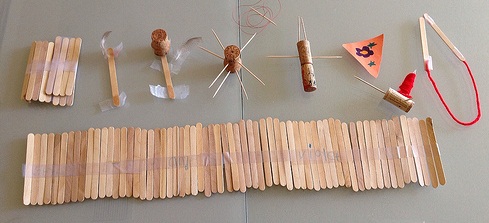
Michelle begins:
My time at the schoolhouse has always been inspiring. Who wouldn’t be inspired in that creative environment, immersed in love? However, today things happened on a whole new level, and I caught a glimpse of how wonderfully amazing learning can be.
After spending too much time last night researching uninspired, tired old Thanksgiving crafts, I narrowed it down to a couple of options. I presented my “exciting” idea to the first group, who were apathetic at best but compliant nonetheless. And I am pretty certain that a few “important” things were learned as we talked about the cornucopia and made collages of the different foods served at Thanksgiving meals past and present. The next go-around, I offered this project and was met with the same unenthusiastic response from the second group of kids. I said “OK, then what do you want to do?” Almost immediately, the kids started throwing out ideas. Here is my perspective on what transpired.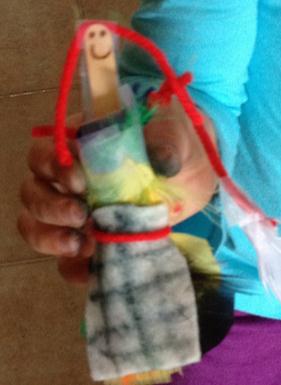 Alaira invented a new crocheting technique using toothpicks and yarn, which she taught to Sophia and Lola, who then used it to make clothes like the pilgrims wore. I took that opportunity to introduce the book A Day in the Life of a Pilgrim Girl, showing and reading to them a few pages about the work the pilgrims had to do, clothes they wore, etc. We chatted about how many clothes were in our girls’ closets at home today and the quantity of clothes they thought the Pilgrim girls had. We talked about having to make each piece of clothing by hand with limited materials vs. going to the store to choose from among hundreds of options.
Alaira invented a new crocheting technique using toothpicks and yarn, which she taught to Sophia and Lola, who then used it to make clothes like the pilgrims wore. I took that opportunity to introduce the book A Day in the Life of a Pilgrim Girl, showing and reading to them a few pages about the work the pilgrims had to do, clothes they wore, etc. We chatted about how many clothes were in our girls’ closets at home today and the quantity of clothes they thought the Pilgrim girls had. We talked about having to make each piece of clothing by hand with limited materials vs. going to the store to choose from among hundreds of options. 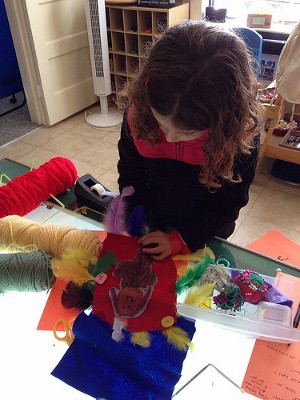 Lola, who had discovered the sewing boxes the day before, quickly chose to work with those materials again. She threaded the needles, and I showed her how to double the thread and tie a knot. Then we pulled out the buttons and she began to sew them on. She kept building on her idea with more excitement as each new thought popped up in her head: making a gingerbread girl out of felt, then sewing it onto another felt piece that she decorated with buttons. She could not find the brown felt she wanted, so she decided to color the gray piece brown (very resourceful).
Lola, who had discovered the sewing boxes the day before, quickly chose to work with those materials again. She threaded the needles, and I showed her how to double the thread and tie a knot. Then we pulled out the buttons and she began to sew them on. She kept building on her idea with more excitement as each new thought popped up in her head: making a gingerbread girl out of felt, then sewing it onto another felt piece that she decorated with buttons. She could not find the brown felt she wanted, so she decided to color the gray piece brown (very resourceful).
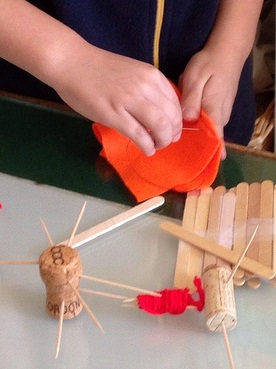 Sophia was soon engaged in the minute details of making a ballerina doll with felt and markers, feathers and pipe cleaners. Liam, pretty much uninterested in the clothes and doll making, was watching Alaira with the toothpicks and started tinkering with them. I offered a few suggestions of items he could make that related to the Thanksgiving story, and his eyes showed a glint of interest when I suggested a boat. So a boat it was; the Mayflower was what I called it, after the one on which the first pilgrims came over from England. He then got out the corks and I watched him become completely engaged in building, using toothpicks, corks, and tape—and more tape.
Sophia was soon engaged in the minute details of making a ballerina doll with felt and markers, feathers and pipe cleaners. Liam, pretty much uninterested in the clothes and doll making, was watching Alaira with the toothpicks and started tinkering with them. I offered a few suggestions of items he could make that related to the Thanksgiving story, and his eyes showed a glint of interest when I suggested a boat. So a boat it was; the Mayflower was what I called it, after the one on which the first pilgrims came over from England. He then got out the corks and I watched him become completely engaged in building, using toothpicks, corks, and tape—and more tape.
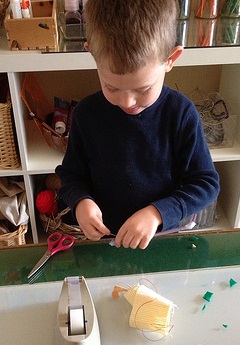 Then everyone thought tape was a good tool for all of the various projects. So I bit my tongue and let the roll dwindle down, though I did try to suggest glue a couple of times. Gavin saw Liam’s design and decided to begin building his own creation with corks and toothpicks.
Then everyone thought tape was a good tool for all of the various projects. So I bit my tongue and let the roll dwindle down, though I did try to suggest glue a couple of times. Gavin saw Liam’s design and decided to begin building his own creation with corks and toothpicks.
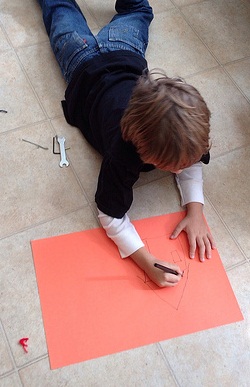 Damon came over and watched for a couple of minutes; then he turned around and pulled out the popsicle sticks and started toying with them. “Hey!” I said, “That reminds me of the houses the Pilgrims had to build.” “Yeah, that’s what I was thinking!” he said excitedly, with a big smile and bright eyes— nothing at all like the glazed-over look in the eyes of the kids (my own included) who were following my chosen project of the Thanksgiving collage a little while earlier. So I got out a few other books, including A Day in the Life of a Pilgrim Boy, and turned to pages that showed the houses that were built out of planks they brought from England and rough wood from chopped trees and topped with thatched roofs.
Damon came over and watched for a couple of minutes; then he turned around and pulled out the popsicle sticks and started toying with them. “Hey!” I said, “That reminds me of the houses the Pilgrims had to build.” “Yeah, that’s what I was thinking!” he said excitedly, with a big smile and bright eyes— nothing at all like the glazed-over look in the eyes of the kids (my own included) who were following my chosen project of the Thanksgiving collage a little while earlier. So I got out a few other books, including A Day in the Life of a Pilgrim Boy, and turned to pages that showed the houses that were built out of planks they brought from England and rough wood from chopped trees and topped with thatched roofs.
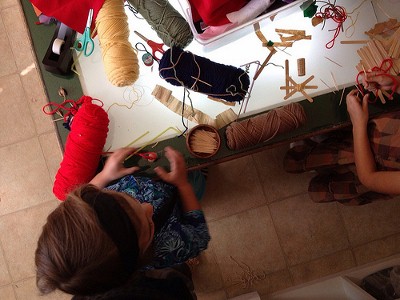
All of this took place in the Atelier, around the light table. While I sat on a stool casually mentioning things about the first Thanksgiving and how it related to what they were each working on, five girls and three boys stood around the table—completely, effortlessly, and passionately engaged in their chosen work. The table was stocked full of felt, pipe cleaners, markers, feathers, corks, toothpicks, construction paper, sewing kits, glue, scissors, yarn, popsicle sticks, and tape. The Zen of learning unfolded before my eyes.
Creative thinking, problem solving, geometry, measurement, math, art, cooperation, sharing, turn taking, community, support, fine motor coordination, history, listening, pride, and accomplishment were all at that table. There was no fighting or resistance, even with only one roll of tape! They were working individually and simultaneously—yet together on a higher level of creative energy flowing easily around the room. One idea would pop up and inspire another, then another. The children took short breaks to look up from their work, just long enough to see a friend’s project, make a contribution to the Thanksgiving conversation, or show me or their friends how awesome what they were doing was.
And it was.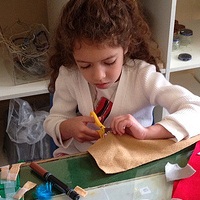 Andrea adds:
Andrea adds:
Yes. Give them what they need to thrive, and then get out of their way. Our role as parents and educators is to be there to offer support, but not to do it for them.
Whether your children are learning in a traditional school setting, at home, or in a co-op or hybrid program, I strongly encourage you to get your hands on the book Project-Based Homeschooling: Mentoring Self-Directed Learners by Lori Pickert, read it, and try implementing some of these things at home. Project-based learning doesn’t have to be all or nothing. It doesn’t have to be your entire curriculum (although it could be), so if you’re a structured Latin-loving Classicist or a relaxed unschooler, project-based learning can still be brought in. It should be. Carve out time for your children to do self-chosen project time. Your children will thank you!
Michelle Foreman and Andrea Gaudin Triche













